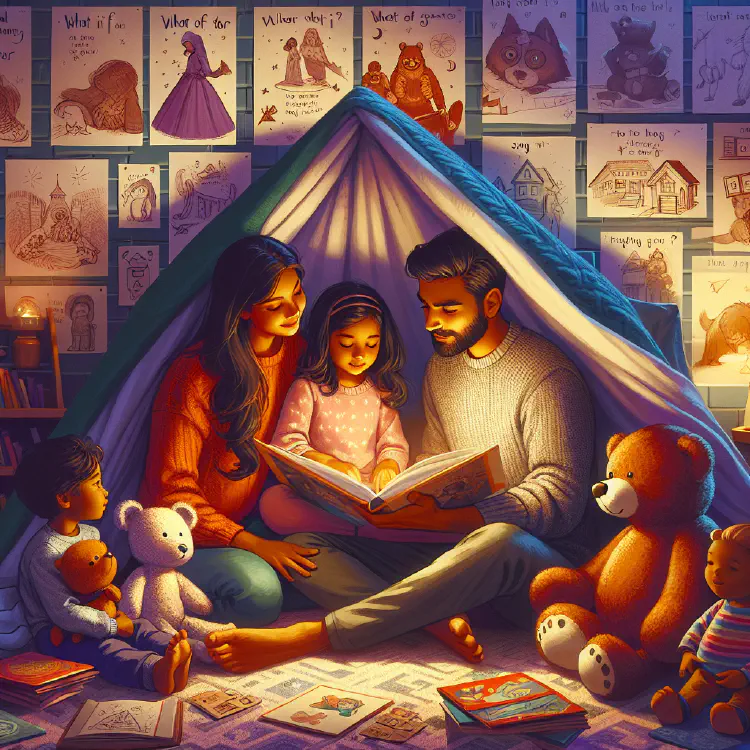How to Involve Kids in Creating Their Own Sleep Stories
Involving children in creating bedtime stories enhances creativity, strengthens bonds, and makes nighttime routines more enjoyable. Various techniques can be used to craft engaging stories together.
- 4 min read

Bedtime can be a challenging time for both parents and children. As the day winds down, it’s essential to create a calming environment that helps little ones transition from the excitement of playtime to the tranquility of sleep. One effective way to achieve this is through bedtime stories. But what if we took it a step further and involved our children in creating their own sleep stories? This approach not only makes bedtime more engaging but also nurtures creativity and strengthens the parent-child bond. In this blog post, we’ll explore various ways to involve kids in crafting their own bedtime stories, making nighttime routines more enjoyable for everyone.
The Importance of Bedtime Stories
Before we dive into the creative process, let’s take a moment to understand why bedtime stories are so crucial for children’s development. Bedtime stories for preschoolers and toddlers serve multiple purposes:
Language Development: Regular exposure to stories enhances vocabulary and language skills.
Imagination Boost: Stories stimulate creativity and help children develop their imaginative thinking.
Bonding Time: Reading together creates special moments between parents and children.
Relaxation: A consistent bedtime routine that includes stories helps signal to the body that it’s time to wind down.
Love for Reading: Early exposure to books fosters a lifelong love for reading.
Now that we understand the significance of bedtime stories, let’s explore how we can involve our children in creating their own sleep stories.
Starting with a Familiar Foundation
When introducing the concept of creating bedtime stories to your child, it’s helpful to start with familiar elements. Here are some ideas to get you started:
Favorite Characters: Encourage your child to include their favorite book or TV characters in their story. This provides a comfortable starting point for their imagination.
Daily Experiences: Use events from your child’s day as inspiration. This could be a trip to the park, a playdate with friends, or even a simple activity like baking cookies.
Family Members and Pets: Incorporating familiar people and animals can make the story more relatable and enjoyable for your child.
Favorite Places: Whether it’s a grandparent’s house, a favorite vacation spot, or an imaginary world they’ve created during playtime, using familiar settings can help spark creativity.
By starting with these familiar elements, you’re providing a safe and comfortable foundation for your child’s storytelling journey.
Techniques for Collaborative Storytelling
Now that we have a starting point, let’s explore some techniques for creating bedtime stories together:
- The “What If” Game
This simple yet effective technique involves asking your child “what if” questions to build a story. For example:
- “What if your teddy bear could talk? What would he say?”
- “What if we could fly? Where would we go?”
- “What if we found a magic door in our house? Where would it lead?”
These questions spark imagination and help children think creatively about different scenarios.
- Story Starters
Provide your child with an intriguing opening line and let them continue the story. Some examples could be:
- “Once upon a time, there was a friendly dragon who loved to…”
- “In a faraway land, there lived a little girl who could talk to animals…”
- “One night, when everyone was asleep, all the toys in the room came to life…”
This technique gives children a jumping-off point while allowing them the freedom to take the story in any direction they choose.
- Picture Prompts
Use illustrations from books or simple drawings as prompts for storytelling. Show your child a picture and ask them to create a story around it. This visual stimulation can be particularly helpful for younger children or those who are more visually oriented.
- Collaborative Storytelling
Take turns adding to the story, with each person contributing a sentence or two. This back-and-forth approach can lead to unexpected and delightful plot twists while teaching children about narrative structure and cooperation.
- Story Dice or Cards
Use specially designed story dice or cards with pictures or words on them. Roll the dice or draw cards and incorporate the images or words into your story. This adds an element of chance and can lead to wonderfully creative and sometimes silly stories.
Creating a Storytelling Routine
To make storytelling a regular part of your bedtime routine, consider the following tips:
- Set Aside Time: Allocate 10-15 minutes before bed for storytelling
